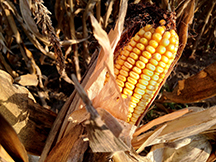Purdue expert: Prepare now for post-harvest drying
October 2, 2014
 |
|
This ear of corn is in an Indiana cornfield that is near harvest in early October. (Purdue Agricultural Communication photo/Keith Robinson) |
WEST LAFAYETTE, Ind. - The nearly ideal weather that has been credited with helping produce an expected record corn crop in Indiana also is yielding concerns that some of the grain will be harvested wetter than normal and require more artificial drying for storage.
"It looks like it's going to be a great crop, and it definitely looks like it could be a wet harvesting year," said Klein Ileleji, associate professor of agricultural and biological engineering at Purdue University. "Farmers should be working now to avoid problems later on."
Adequate drying is an especially important consideration for growers who plan to store their crop rather than sell it immediately, Ileleji said. Excess moisture makes stored grain more susceptible to spoilage.
Under more normal conditions, farmers would bring in their corn with a moisture content of about 20 percent, Ileleji said. The grain can be safely stored for six months with moisture content of 15 percent and up to a year at 14 percent.
This year, because cooler temperatures and damp air delayed dry-down in the field, some farmers could be bringing in crops with moisture content of 25 percent or higher.
Wringing out that extra moisture will be a challenge, Ileleji said.
"We typically talk about taking out 5 percent or more of the moisture in the drying process. Now we could be talking about 10 percent or more for some of the crop," he said.
Drying units could be taxed by the extra work, so farmers should make sure their equipment is in good working order, Ileleji said.
"Wet corn will not flow smoothly through the machine and could clog the mechanism," he said. "Because post-harvest drying is a time-consuming process, there is a tendency to try to do too much at once, which simply leads to breakdowns and additional delays."
Ileleji stressed that operators should never reach into a drying unit or storage bin with flowing grain to clear a jam.
"That is a significant safety hazard," he said.
Despite the additional work and expense associated with an extended drying operation, Ileleji advised farmers who might have a moisture issue not to wait too long for their crop to dry down in the field before harvesting.
"We are already pushing the outside of the weather envelope in late October," Ileleji said. "It is better to bring the crop in wet than to have it freeze."
Despite high moisture content in some parts of the state, most of Indiana's corn crop appears to be in good shape for harvesting, with few signs of ear rot or other toxic fungal diseases that could thrive in wet conditions, said Bob Nielsen, Purdue Extension corn specialist.
"We are amazingly on track," Nielsen said.
Recent warmer, drier weather throughout much of the region has helped the dry-down.
"We've been losing one-half to three-quarters point a day in moisture content over the past seven to 10 days," he said. "That's very good for this time of year."
Once the corn is brought in, farmers should have plenty of propane to fuel their drying equipment, said Wally Tyner, a Purdue agricultural economist specializing in biofuels.
Last year, national propane stocks were about average heading into the drying season, Tyner said. But after a large, wet harvest similar to this year, farmers used nearly four times as much propane to dry their crops as they did in 2012, quickly drawing down the reserves and helping to lead to critical shortages of the gas later when the region plunged into one of the coldest winters on record.
Tyner said propane inventory is now running about 20 percent above last year. He advised farmers to fill up their tanks now before high demand and slick winter roads made supply more difficult in the coming weeks and months.
"It's simply better to be prepared," he said.
Writer: Darrin Pack, 765-494-8415, dpack@purdue.edu
Sources: Klein Ileleji, 765-494-1198, ileleji@purdue.edu
Bob Nielsen, 765-494-4802, rnielsen@purdue.edu
Wally Tyner, 765-494-0199, wtyner@purdue.edu
Ag Communications: (765) 494-2722;
Keith Robinson, robins89@purdue.edu
Agriculture News Page

